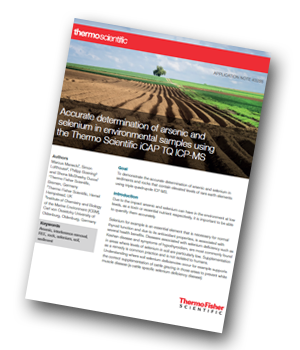Thermo Fisher Scientific has produced an application note demonstrating the accurate determination of arsenic and selenium in sediments and rocks that contain elevated levels of rare earth elements
using triple quadrupole ICP-MS.
 Introduction
Introduction
Due to the impact arsenic and selenium can have in the environment at low levels, as a toxin or essential nutrient respectively, it is important to be able to quantify them accurately. Analysis of arsenic and selenium by ICP-MS is challenging due to multiple spectral interferences, and becomes especially challenging in the presence of high amounts of rare earth elements (REEs) such as dysprosium, gadolinium, neodymium, samarium or terbium due to the formation of doubly charged ions. These doubly charged REEs lead to false positive results on arsenic and selenium and as such lead to incorrect conclusions and actions based on that data.
Triple quadrupole ICP-MS offers improved interference removal for such challenging applications through the use of selective reaction chemistry to produce higher mass ions, which can either mass shift analytes into an interference free region of the mass spectrum or mass shift interferences away from analytes.
This application note evaluates the efficiency of TQ-ICP-MS measurement modes and compares them
to single quadrupole (SQ) ICP-MS measurement modes with the Thermo Scientific™ iCAP™ TQ ICP-MS for the quantification of arsenic and selenium in the presence of REEs.
Results
External calibrations for arsenic and selenium in the range 0.2 to 5 μg·L-1 show excellent linearity and LODs of 0.17 ng·L-1 and 2.02 ng·L-1 for 75As and 78Se respectively, when using TQ-O2 mode. The carbon enhancement effect of methanol in the samples is seen as an approximate 2-fold increase in sensitivity for both analytes, compared to typical sensitivities without methanol.
Conclusion
The iCAP TQ ICP-MS was used to measure trace levels of arsenic and selenium in complex environmental matrices. The measured concentration for arsenic in the certified geological material was in agreement with reference values and the spike recoveries for both arsenic and selenium in both samples were determined in the range 93-98%. The TQ-O2 mode shows the lowest BECs for arsenic and selenium in the presence of high concentrations of REEs when compared to the other analysis modes. The TQ-O2 mode is an ideal mode for interference removal in rocks, soil and sediment samples
where high REE concentrations can be expected.




